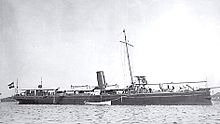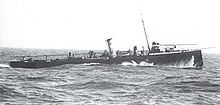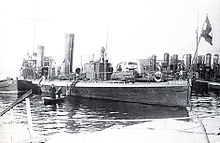SMS satellite
|
|
|
|---|---|
 The kuk SMS satellite |
|
| Overview | |
| Type | Torpedo gunboat , destroyer |
| Shipyard |
Schichau-Werke , Elbing |
| Keel laying | January 1892 |
| Launch | September 21, 1892 |
| delivery | June 24, 1893 |
| Decommissioning | 1918 |
| Technical specifications | |
| displacement |
529 t, maximum 616 t |
| length |
69.32 m |
| width |
8.15 m |
| Draft |
2.90 m |
| crew |
84 men |
| drive |
4 cylinder boilers , |
| speed |
23 kn |
| Range |
4000 nm at 12 kn |
| Armament |
1 × 70 mm Skoda L / 42 cannon, |
| Coal supply |
143 t |
| similar boats | |
The torpedo cannon boat SMS Satellit, which was ordered from Schichau in 1892, was the fastest boat of the Austro-Hungarian Navy from delivery to delivery of the Magnet, which was also built at Schichau . The size and propulsion of the satellite differed significantly from the three "torpedo ships" of the Meteor class delivered in 1887/1888 . The following magnet also clearly differed from it with its two chimneys. In terms of size, appearance and technical design, the Trabant (1890, 610 tons) built in Trieste was the most similar boat in the Austro-Hungarian Navy. The satellite was considerably modernized in 1912 by installing modern Yarrow boilers . With this change, she also got three new tall chimneys that gave her a completely unique look. The satellite remained in service in coastal defense until the end of the war.
Building history
The Austro-Hungarian Navy began placing orders for torpedo boats for coastal defense in 1885. The first contractor was the F. Schichau in Elbing , which in 1886 with SMS Sperber and Habicht the first boats of this 78 t displacement type. In 1888 and 1889 five more boats of this type from Schichau followed, 15 of which were also reproduced in Austria. Similar to the so-called “division torpedo boats” in Germany, the Austro-Hungarian Navy ordered the three boats of the 360-tonne Meteor class as “torpedo ships” from Schichau at about the same time . However, other applicants were also considered here. In 1889 the Planet was launched at Palmers in Jarrow , and in 1890 the Trabant at Stabilimento Tecnico Triestino in Trieste . The two 500-ton boats did not quite meet expectations, in particular they did not reach the required top speeds.
Nevertheless, the Austro-Hungarian Navy ordered a very similar type from Schichau in 1891, to which a large proportion of the steel used was to be supplied from Austria. The boat with twin-screw propulsion started under construction number 482 in January 1892 was finally named SMS Satellit , launched on September 21 and carried out its first sea test between Pillau and Hela on December 30, 1892 , reaching 21.86 knots were.
The first double screw ship of the kuk Kriegsmarine delivered by Schichau had four cylinder boilers that were operated with up to 13 atm pressure and generated the steam for two triple expansion machines that could produce up to 4800 PSi. With this up to 23 knots were reached. With a coal supply of 143 t, the new boat had a cruising range of 4000 nm at 12 kn.
The boat was armed with a 70 mm L / 42 Skoda cannon and eight 47 mm L / 44 Skoda rapid fire guns, which were set up on the sides. These guns corresponded to the models used on the predecessors Planet and Trabant . The torpedo tubes were of the larger caliber 45 cm; the torpedo armament consisted of a rigid bow tube and a rotating tube on the quarterdeck.
On March 21, 1893, the satellite began its transfer journey into the Mediterranean. On the way, the boat visited Dartmouth for a week, ran shortly to Brest , visited Cádiz , called Gibraltar and then visited Palermo , before arriving in the Austrian naval port of Pola on April 21 . In the arsenal there, the equipment of the boat was completed.
Mission history
The SMS satellite , which arrived in Pola in April , was put into service on June 24, 1893. She first carried out tests on torpedo armament in the Fasana Canal before being assigned to the fleet squadron. In the spring of 1894 the mine-throwing device of the boat, which had already been constructed during construction, was installed. The facility for 20 mines was accepted. In a speed test under operational conditions on April 12, she only reached a speed of 19.75 kn. On April 16, the boat collided with the ironclad Habsburg , where the bow was badly damaged and the bow torpedo tube broke. The satellite was unleashed until September to complete the repair. In 1895 the boat, which had meanwhile been repaired, was not actively used, but only again in the summer of 1896.
Operation in front of Crete
The landing of Greek troops in Crete in February 1897 during the Turkish-Greek War led to the intervention of the great powers and the Austro-Hungarian Navy was one of the massively intervening units. A total of 20 ships and boats of the Austro-Hungarian Navy were deployed off Crete and the Austrian Navy Association was at times the third largest after the Royal Navy and the Italian Regia Marina with 16 units .
The satellite moved on February 17, 1897 together with the torpedo boats Sperber , Kiebitz and Elster as the first reinforcement group to Crete. The flagship of the Austrian Intervention Association was the armored cruiser SMS Kaiserin and Queen Maria Theresia . The tower ship SMS Kronprinzessin Archduchess Stephanie and the older torpedo ship SMS Sebenico were already on site. The marching division filled Teodo on 19/20. February her bunkers again and reached Canea on the 22nd . While the small torpedo boats had considerable difficulties in the wintry weather conditions, the satellite arrives at suspicious ships in the first few days of use. The Austrian units constantly changed their locations and were reinforced by the torpedo cruiser SMS Tiger , the torpedo cannon boats Blitz and Komet and another five torpedo boats until mid-April.
The Cretan state created under pressure from the great powers led to an extensive withdrawal of intervention units.
The satellite only left the mission unit off Crete, which now comprised only eight units, on December 13th, in order to head north with the unit's new flagship, the coastal armored ship SMS Wien . The satellite visited Syra on the way and then Smyrna , where the Wien had gone and stayed until over Christmas. The satellite began its march back home on December 18, 1897 and arrived back in Pola on the last day of the year. Its operating time off Crete was only exceeded by the torpedo cruiser Tiger . On January 4, 1898, the boat was decommissioned.
Further usage and modifications
The satellite was in service after its mission in Crete in the summer of 1898 and 1900 and was otherwise in reserve. In the winter of 1902, the boiler and machinery were overhauled before the boat took part in the summer exercises. 1904 took place on a trip abroad in April / May on which she caught up in Smyrna to the squadron practicing in the Levant with the ships of the line Habsburg and Arpad as well as the coastal armored ship Monarch and then marched on via Alexandria , Kefalonia and Valona .
On January 3, 1905, the satellite made some experiments off Pola when the torpedo boat N ° XXXVIII tried to overtake it, but the satellite rammed and sank. The commander was acquitted of all guilt for causing the accident, but convicted for failing to initiate rescue measures and dismissed. In 1905 another trip abroad took place from February to April, in which several ports in the Levant were called. The satellite ran out together with the cruiser Aspern to join the ships of the line Habsburg , Arpad and Babenberg in Piraeus . The squadron also included the frequently detached cruiser Szigetvár . There were longer stays from February 20th to March 8th in Saloniki and from April 17th to 6th in Smyrna. In the late summer of 1905, the satellite collided again with a torpedo boat as part of a night exercise. On December 23, 1905, the boat was decommissioned and assigned to the reserve in 1906. The again considerably deformed bow torpedo tube was removed and the bow closed. Two sideways rotating torpedo tubes were installed on deck behind the bridge. Despite this modernization, the boat remained in the reserve in 1907 and 1908 and was not put back into service until February 15, 1909.
The new stationing place for the boat was Lussin and then in January 1910 Teodo (today Tivat). From October the boat was primarily available to the Naval Academy in Fiume . But it also took part regularly in the summer maneuvers until it was decommissioned on August 15, 1912 for a major overhaul.
The boat received three modern Yarrow boilers and three chimneys. After initial tests, this was expanded and increased by one meter. Finally, a drive power of 4137 hp was determined and a top speed of 21.18 knots was achieved. As a three-chimney destroyer, the satellite was put back into service on June 14, 1913 and carried out surveying tasks around the Istrian peninsula. Launched on October 25th, it resumed its activity on March 14th, 1914.
War effort
At the start of the war in 1914, satellite was in front of Porto Ré and then went to Pola, where the mine system was installed and then took over 60 mines to supplement the defensive mine locks. In the following years she moved submarines in tow to Cattaro , but also back to Pola. In 1915 and 1916 she then carried out local security tasks in the Pola - Fiume area.
On August 1, 1916, the satellite discovered the crew of the Italian submarine Giacinto Pullino, which had struck the small Dalmatian island of Galiola the day before, fleeing on a sailing boat . The submarine's navigational officer who fled separately, Nazario Sauro , an Istrian who had volunteered for the Italians at the start of the war, were also discovered. As an Austrian citizen, Sauro was executed in Pola on August 10, 1916.
In October 1916, the boat was stationed in Cattaro and mainly provided escort service until the end of the war. In addition, some mine laying and mine search operations were carried out. After the surrender in 1918, the British administration of the base took over the boat.
End of the satellite
The SMS satellites were awarded to France in 1920 and delivered in tow via Bizerta to Toulon , where they were scrapped in 1921.
The torpedo vehicles of the Austro-Hungarian Navy
| Surname | Shipyard | Launch | in service | size | Armament | Final fate |
|---|---|---|---|---|---|---|
| meteor | Schichau , Elbing | 05/15/1887 | 3.09.1887 | 360 t, 58.7 m, 23.1 kn | 9 × 47 mm SK, 1 × TR | 1920 Italy, scrapped |
| lightning | Schichau, | 07/07/1888 | 10/26/1888 | 358 t, 60.7 m, 21.3 kn | 9 × 47 mm SK, 1 × TR | 1920 Italy, scrapped |
| comet | Schichau, | 08/18/1888 | 10/25/1888 | 358 t, 60.7 m, 20.6 kn | 9 × 47 mm SK, 1 × TR | 1920 Italy, scrapped |
| planet | Palmers , Jarrow | 06/25/1889 | 12/6/1891 | 490 t, 66.9 m, 19.3 kn | 2 × 70 mm, 8 × 47 mm SK, 2 × TR | 1920 Italy, scrapped |
| Trabant | STT , Trieste | May 21, 1890 | 11/23/1890 | 530 t, 68.8 m, 20.3 kn | 2 × 70 mm, 8 × 47 mm SK, 2 × TR | 1920 Italy, scrapped |
| satellite | Schichau, | 09/21/1892 | 6/24/893 | 529 t, 69.3 m, 23 kn | 1 × 70 mm, 8 × 47 mm SK, 2 × TR | 1920 France, scrapped |
| magnet | Schichau, | 03/21/1896 | 5.07.1896 | 485 t, 71.0 m, 25.9 kn | 6 × 47 mm SK, 3 × TR | 1920 Italy, scrapped |
literature
- Robert Gardiner, Roger Chesneau, Eugène M. Kolesnik (eds.): Conway's all the World's Fighting Ships, 1860-1905 , Conway Maritime Press, London 1979, ISBN 0-85177-130-0
- Jane's Fighting Ships of World War I, ISBN 1-85170-378-0
- Erwin Sieche: torpedo ships and destroyers of the K. u. K. Marine , Marine-Arsenal: Volume 34, Podzun-Pallas-Verlag, Wölfersheim-Berstadt (1996), ISBN 3-7909-0546-1
- B. Weyer: Taschenbuch der Kriegsflotten , JF Lehmanns Verlag, Munich, 1905
Web links
- Torpedo ships of the Austro-Hungarian Navy (accessed on April 27, 2012; PDF; 1.3 MB)
- SMS satellite on kuk-kriegsmarine (accessed on May 9, 2012)
- Side elevation of the 1893 satellite on blueprints (accessed May 9, 2012)
- Side view of the satellite after conversion to homepages (accessed on May 9, 2012)



